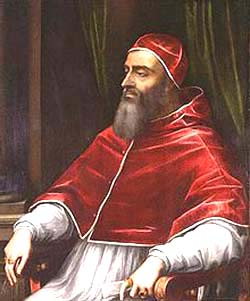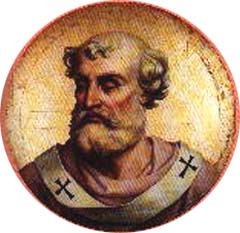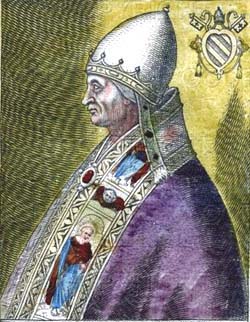 |
About the Church
The Infallibility of the Church - III
Can a Pope Err in Doctrinal, Liturgical
& Canonical Matters?
Atila S. Guimarães
These notes are taken from an article in the Brazilian monthly Catolicismo (November 1976) summarizing a matter published in the Belgian periodical Mysterium Fidei (n. 33, July 1976). I am just selecting some parts of the summary that I consider opportune for TIA readers.
Is this old news? The dates of the publications are obviously old, but since the subject is doctrinal and historical, it does not lose its relevance.
*
When the question of papal infallibility proclaimed at Vatican Council I is studied in detail (here and here), we see that when it comes to the exercise of the personal teaching of a Pope, infallibility does not cover all pontifical acts. It is for this reason that many theologians study the various cases of a scandalous Pope, a heretical Pope or a schismatic Pope… Actually the cases where personal papal infallibility is involved are rare.
Instead, some historical examples show how Popes erred in the past and thus illustrate that they can be considered fallible in their personal teachings and actions.
John XXII and Benedict XII
Pope John XXII defended that after death, the souls of the elect would await the resurrection of the flesh and the Final Judgment before enjoying the beatific vision of God. Similarly, he defended that neither the devils nor the condemned souls would suffer eternal punishment in Hell before that day.

Pope John XXII retracted his errors on his deathbed |
He presented these singular opinions in three sermons delivered respectively on November 1, 1331, December 15, 1331 and January 5, 1332. Such opinions seemed to have some base on Scriptures, but the whole of Tradition was opposed to them, even though most of the revealed doctrines regarding this topic had not yet been defined at that time.
Nonetheless, based on the opinions of several theologians interpreting the Church Doctors, the Sovereign Pontiff insisted in his opinions, going as far as to publish a book to support that thesis.
Since the opposition of the faithful was becoming very strong, the King of France asked the theologians of the University of Paris and the religious Orders to study the subject. They reached a conclusion contrary to that of the Pope.
In the consistory of January 3, 1334, John XXII declared that he was disposed to retract his thesis if it were proved to be against the common doctrine of the Church. In fact, he retracted his opinion on December 3, 1334, the eve of his death. In the presence of the College of Cardinals, he signed the Bull Ne super his by which he officially revoked the doctrine he had upheld.
His successor, Benedict XII, published his predecessor’s Bull of apology. Some years later, he officially defined, as a truth of Faith, the opinion contrary to that of John XXII. This historic fact makes it evident that a Pope is not infallible in all of his teachings.
Clement VII
In the 16th century, many churchmen tried to make a mixture of Renaissance Paganism and Church liturgy and teaching. Consequently, they proposed to celebrate the Catholic feasts based on classical odes taken from pagan Antiquity. It was a question of “adaptation” of the liturgical texts to the needs of the epoch…

Clement VII tried to oblige the Church to accept a Renaissance Liturgy |
In the hymns reformed by humanist Cardinal Zacharias Ferreti, the Virgin Mary was called “felix dea, deorum maxima, nympha candidissima” [o happy goddess, o greatest among the gods, o most beautiful nymph]. Personages from pagan mythology such as Bacchus and Venus were also introduced into the liturgy.
Even though these were profanations of sacred matters that resulted from the Renaissance delirium, the consequence of those “experiments” was approved by Clement VII in a Brief issued on December 11, 1525. In this document, after enthusiastic praise for the innovations, the Pope wrote these words: “By our own determination and secure knowledge, We concede and command with apostolic authority by the content of these letters, that all the faithful, including the priests, can use these hymns, even in the Divine Offices.”
It is understandable that St. Pius V, when he brought to a close the abuses that had infiltrated the celebration of the Holy Mass and the liturgical offices, did not refer to that unprecedented papal document of Clement VII. He simply treated it as non-existent.
Nonetheless, there were persons then who thought that it was correct to imitate those Renaissance fashions and introduce them into religion. Let this example serve to instruct the clergy and the faithful that legitimate obedience to superiors should follow the teaching of St. Thomas who said, “It is not necessary to obey the Prelates in everything.”
Stephen VI and Sergius III
In a semblance of a trial, Pope Stephen VI commanded the body of Pope Formosus, who had died nine months earlier, to be disinterred. The decaying cadaver was then dressed in pontifical vestments, set on a throne and submitted to an intense interrogation. At the side of Formosus’ corpse a deacon stood to respond on behalf of him. At its conclusion, Stephen VI gave a speech insulting the remains of Formosus and declaring his election null. He also declared all the consecrations of Bishops and acts made by Formosus to be invalid, and ordered the three fingers of Formosus’ right hand used in consecrations to be severed.

Stephen VI called the "cadaver synod" and caused canonical chaos |
That ceremony took place in a synod, with many Prelates attending and approving by their presence those irregular actions of Stephen VI. Finally, the cadaver was divested of its vestments. They even tried to remove the discipline that Formosus used, but could not because it was embedded in his flesh. An earthquake that shook the Lateran Basilica on that occasion was disregarded by the authors of that ignominious posthumous “trial,” which became known in History as the “cadaver synod.’
The people of Rome, highly indignant, imprisoned Stephen VI some time later, gave him monk’s garb, and strangled him in prison. The successors of Stephen VI made reparation for the abuses against Pope Formosus performed at the “cadaver synod”. However, Sergius III (904-911), a cruel, mundane and dissolute man who gave rise to “pornocracy,” reissued the measures against the ordinations and consecrations of the Bishops made by Formosus, obliging the Bishops and priests - under penalty of exile, prison or excommunication - to be re-consecrated and re-ordained.
Innocent IV
Robert Grosseteste, the English Bishop of Lincoln (1235-1253), was an erudite, pious and zealous man who sought to reform his clergy. He turned his attention in particular toward those who had received high appointments through special privileges and did not fulfill their obligations.

Innocent IV was duly resisted in his pretention to favor his nephew |
Pope Innocent IV, however, did not hesitate to name one of his nephews to be a Canon in the Chapter of the Cathedral of Lincoln, ordering the Bishop to install his nephew without delay.
In a letter of remonstrance, Bishop Grosseteste serenely answered the Pope:
“Precisely because of the obedience that binds me and for the love of my union with the Holy See in the Body of Christ, as an obedient son, I disobey, I contradict, I rebel. I resist your command. You cannot take action against me, for my every word and act is not rebellion but the filial honor due by God's Commandment regarding father and mother.
"As I have said, the Apostolic See in its holiness cannot destroy, it can only build. This is what the plentitude of power means; it can do all things toward edification. But these privileges [your request for your nephew] do not build up, they destroy. Therefore, they cannot be the works of the blessed Apostolic See.”
Furious, Innocent IV wanted to punish Bishop Grosseteste, but his advisors dissuaded him because it would be a scandal for all Christendom.
*
The deposit of the Faith is transmitted, and the acts of the Church Magisterium - either the supreme or the ordinary Magisterium - are inerrant to the degree that they conform to Catholic Tradition. The cases reported in this article demonstrate that a Pope is not impeccable and cannot pretend to be the owner of the Catholic Religion. He is an administrator (Tit 1: 7-9) who should remain within the limits of the norms for the exercise of his mandate. St. Paul lists these norms:
- “To keep the deposit of the Faith” (1 Tim 6:20);
- “Before all else, to transmit what he had received” (1 Cor 15:3);
- “To edify and not destroy” (2 Cor 10:8);
- “To keep the Traditions” (2 Tes 2:14);
- “To withdraw from any brother who walks disorderly, not following the
received tradition” (2 Thes 3:6);
- “To show himself faithful as the dispenser of the Faith” (1 Cor 4:1-2).
Bishops and Popes, as successors of the Apostles and of the Prince of the Apostles, have a mission determined by the divine constitution of the Church. She must lead men to God, so that they may unite themselves with the Creator without impediments. The Church can never lose sight of this strictly religious and supernatural goal. The way the Church accomplishes this supernatural goal is indicated by Revelation itself. Hence, the obligation to follow Tradition, according to the precept of St. Paul given to the Galatians: “Even if we or an Angel from Heaven were to preach a Gospel to you different from what we have preached to you, let him be anathema” (1:8).
1. Denzinger-Schometzer, n. 980;
2. Ludwig Pastor, Istoria dei Papi, Desclée de Brouwer, vol. 4, p. 418.
3. Summa theologica, 2,2, q. 104, a. 5.
4. Mangenot Vacant and Michel Amant, Dictionnaire de Théologie Catholique, vol 14. columns 1918-1921.
5. “Robert Grosseteste: Pillar of the Papacy", Christian Order, vol. 16, n. 12, December 1975, col. 722-723.
6. Pius XII, Allocution of March 6, 1956. .

Posted May 21, 2012

Related Topics of Interest
 Infallibility: First Requirement to Accomplish Christ’s Mandate Infallibility: First Requirement to Accomplish Christ’s Mandate
 What Is Papal Infallibility? What Is Papal Infallibility?
 How Should a Catholic Act before Bad Popes? How Should a Catholic Act before Bad Popes?
 St. Paul's Teaching on Facing False Teachers of Doctrine St. Paul's Teaching on Facing False Teachers of Doctrine
 Marvelous Continuity and Shocking Change Marvelous Continuity and Shocking Change
 Newman against Papal Infallibility Newman against Papal Infallibility

Related Works of Interest
|
About the Church | Home | Books | CDs | Search | Contact Us | Donate

© 2002-
Tradition in Action, Inc. All Rights Reserved
|
 |
|